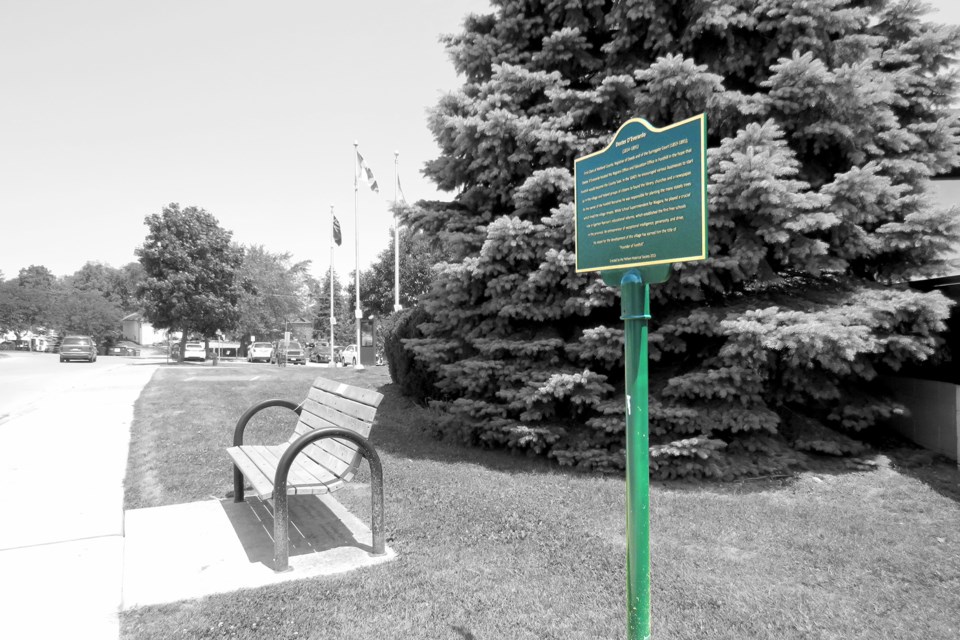Just outside Pelham Town Hall, to the south of the flag poles, there is a small bronze plaque honouring Dexter D’Everardo, to whom some refer as being the “Founder of Fonthill.” The plaque was erected in 2015 by the Pelham Historical Society, which both fundraised for it and provided the plaque’s content.
One of Mr. D’Everardo’s accomplishments was to work as the school superintendent for Niagara, and unfortunately in that context the plaque also mentions that he collaborated in Egerton Ryerson’s educational reforms. Those “reforms” included what became known as First Nations “Residential Schools,” the horrors of which are just now becoming well known to the wider—more accurately, “whiter”—world. Their legacy of torment has long been seared into the consciousness of generations of Indigenous peoples. There are no shades of grey here: Residential Schools are a national shame.
The Town of Pelham now finds itself with an extremely regrettable association because of a sign that need not be written as it is, nor located where it is (need it be anywhere?).
In 2015, when the Truth and Reconciliation Commission produced its final report and recommendations, many Canadians were surprised by how often these recommendations addressed education. In light of the findings, a process of reviewing both contemporary educational curricula and Canada’s educational history became focal points. This in turn led to the understanding that Mr. Ryerson clearly played a key role in creating Residential Schools.
As is now explicitly clear to all but the wilfully blind, these schools caused an incalculable amount of damage to Canada’s First Nations through their destruction of language, through their decimation of family units and family bonds, through their calculated loss of culture, and unfortunately in many instances through the deaths of their students, all of which is appalling, deplorable, and an indelible stain on Canadian history.
Some have suggested that Mr. Ryerson has been given a bad rap, that he did much good and that he certainly didn’t encourage abuse. This argument is poorly supported by the evidence—do your own research to see that Ryerson, a Methodist missionary, wanted to convert all Indigenous people to Christianity and felt that women required only elementary-level education.
Or—and this is key—we could rely upon the huge volume of work done by various local school boards that have renamed facilities named after Mr. Ryerson, or look to the large university in downtown Toronto that formerly bore Ryerson’s name. Toronto Metropolitan University—formerly Ryerson University and prior to that Ryerson Polytechnic University—established a “Standing Strong Task Force,” which was charged with investigating Ryerson’s actions and whether or not a name change was appropriate. The task force received submissions and petitions, heard testimony, and ultimately made 22 recommendations, the most significant of which was to change the university’s name. This work—the exhaustive research and the findings—can be relied upon by the Town of Pelham.
In any event, whether or not Mr. Ryerson’s intentions were good (debatable at best), the amount of generational harm that flowed from Residential Schools is not in question. What's more, any claims that this is “revisionist history,” that what we know today is not what we knew then, ring hollow when we make even the slightest effort to look at the documented history of these schools. History is the telling of stories. Whose story is being told, and who does the telling, tells you whose history it is. The facts remain the facts.
For example, responding to internal staff criticism of the schools’ appalling conditions and death rates in 1910—that’s 113 years ago— the Superintendent of Indian Affairs, Duncan Campbell Scott, wrote: “It is readily acknowledged that Indian children lose their natural resistance to illness by habitating so closely in these schools, and that they die at a much higher rate than in their villages. But this alone does not justify a change in the policy of this Department, which is being geared towards the final solution of our Indian Problem.”
These three words—the final solution—should turn cold the blood of genuinely impartial students of history, of which the membership of the Pelham Historical Society is presumably comprised. Both US and Canadian Residential Schools and Indian Reserves were admired by a certain Nazi leader in the 1930s. And when Adolph Hitler is a fan of efforts to erase a culture from the face of the earth, maybe it’s time to reconsider whom you are morally comfortable going to bat for.
Keeping an unnecessary reference to Egerton Ryerson in a plaque about Dexter D’Everardo does nothing for anyone.
As the plaque indicates, D’Everardo accomplished a lot: he was involved in attracting businesses, creating houses of worship, establishing a land registry office, and basically bringing critical services to the area. Why detract from his accomplishments by raising the spectre of Mr. Ryerson? If the two are so closely associated, perhaps we should reconsider the D’Everardo plaque altogether.
The Pelham Historical Society has a meeting next week where this issue will be front and centre on the agenda. We strongly urge the Town of Pelham and the Pelham Historical Society to remove or rewrite the plaque. Nothing this divisive or trauma-causing should be honoured on public property, at a Town Hall that is meant to provide services to all.



